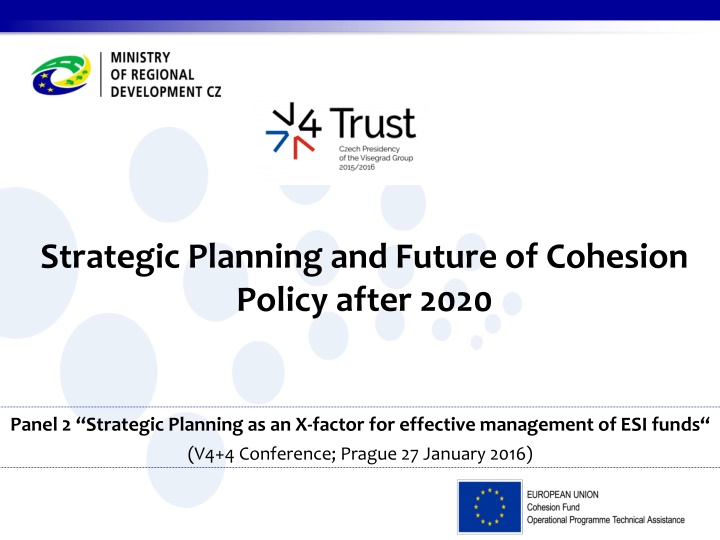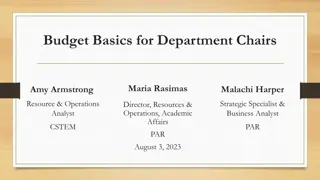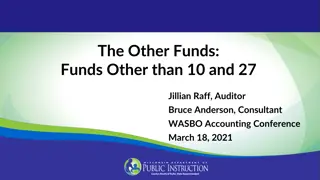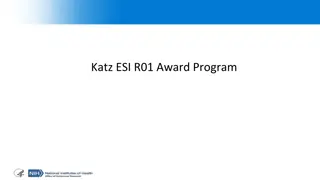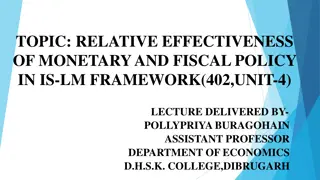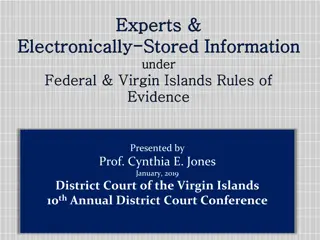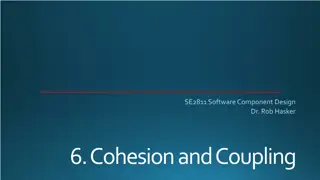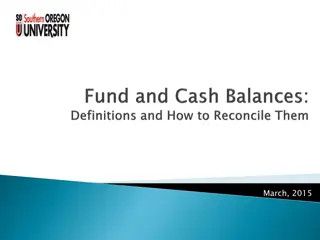Strategic Management of ESI Funds for Cohesion Policy Effectiveness
Strategic planning plays a crucial role in managing ESI funds effectively within the complex and shared governance structure of cohesion policy. From programming to evaluation, aligning interventions with strategic documents is essential for achieving targeted goals. The intervention logic of ESI funds emphasizes planned change, problem analysis, cause identification, and actions that must consider key assumptions and external factors. High-quality strategic management in public administration is necessary to develop and implement tools systematically.
Uploaded on Sep 25, 2024 | 2 Views
Download Presentation

Please find below an Image/Link to download the presentation.
The content on the website is provided AS IS for your information and personal use only. It may not be sold, licensed, or shared on other websites without obtaining consent from the author.If you encounter any issues during the download, it is possible that the publisher has removed the file from their server.
You are allowed to download the files provided on this website for personal or commercial use, subject to the condition that they are used lawfully. All files are the property of their respective owners.
The content on the website is provided AS IS for your information and personal use only. It may not be sold, licensed, or shared on other websites without obtaining consent from the author.
E N D
Presentation Transcript
Strategic Planning and Future of Cohesion Policy after 2020 Panel 2 Strategic Planning as an X-factor for effective management of ESI funds (V4+4 Conference; Prague 27 January 2016)
Key aspects of strategic management of ESI funds Cohesion policy is due to its multilevel governance and shared management nature one of the most complex policies in the world. This has implications for its strategic management. Implementation of ESIF programmes is a result of interaction of quality of strategic management of ESIF (both EU and national/regional level) and strategic management in particular sector of public administration.
Key aspects of strategic management of ESI funds Programmes and also the Partnership Agreement are strategic documents as such. And from programming, through implementation to evaluation they are connected to other strategic documents. Programming: Ex ante conditionalitiesrequires the existence of strategic documents. Implementation: Interventions from ESI funds must be in accordance with strategies (e.g. requirement at the level of project application). There is a pressure on national policies and strategies to precisely formulate problems, needs and solutions. Evaluation: Evaluation of contribution of ESI funds to fulfilling the strategic goals is required.
Intervention logic of ESI funds All this is interconnected with the idea of ESIF intervention logic: Planned change (proposed result of interven- tion to eliminate the choosed causes) Problem analysis (definition of problem to be solved) Problem s causes (identifica- tion of causes of problem) Choice of cause(s) to solve (with ESIF interven- tion) Actions (set of activities making the change happen) And you need to respect: Assumptions which are needed to fulfil the goal (e.g. attitude of target group) External factors (other outside factors which can influence fulfilment of the goal) or actions realised outside of ESIF (e.g. change in legislation)
What can we derive from this? We need (but not only) High-quality system of strategic management in public administration. To create, develop and implement tools for strategic management (methodical, systemic and other).
What can we derive from this? But as we aim for systemic changes in our societies that are facing several unsustainable problems, we need also Embrace the complexity of contemporary challenges and find strategies that go beyond the static intervention logic. Start thinking about the way we usually thing about the strategies in order to enable double-loop learning at strategic level. There is an interesting emerging concept of meta- governance. Application of meta-governance thinking on ESIF strategic management could be a way to change the ESIF regime to be more relevant to today s challenges.
Analysis of strategic management barriers
Challenges Complex set of actors in the system of shared management (clashes of hierarchical and network governance approaches) Accountability (disballance of different aspects of accountability and accountability overload) Low connection between strategies and financial management, financial plans and budgets. There are no variant solutions when making strategy or project. Implementation of strategic documents is not working: not at all ( strategies into the drawer culture ); vague objectives and actions; not measurable; not possible to evaluate and not evaluated.
Biggest strategic management barriers according to V4+4 states Unstable political environment; decision making in terms of political cycle (prevalence of short-term political priorities etc.) (7 of 8 countries choose this as one of the top 5 barriers). The absence of a strong political mandate and support for strategic planning (6/8) The absence of central capacities (a central body) responsible for strategic planning (5/8) The lack of resources (time/capacities/finances) for the preparation of quality strategies (5/8) The lack of liability and accountabilityfor fulfilment of strategic goals (5/8) No one: The swiftly changing (global and/or local) environment
Questions raised From this overview it seems that we feel deficiencies even in what is perceived as good traditional practice in the public sector strategic management. This raises questions: Isn t this just a sign that business as usual is no longer suitable? Should we try hard to get the basics right or skip to more radical re-thinking of strategic management in our public administration.
Challenge Our current mission: Preparation of Czech ESIF 2020+ strategy, this includes questions like What are the needs of CZ in the next programming period How will be cohesion policy conditioned How will be ESIF managed What will be possible to finance from ESIF What amount of money will be available Main challenges: Lack of quality in strategic management on both EU and Czech level Absence of relevant midterm/long-term national top-level strategy
Some key actions Methodical setting - manuals for creating national, regional and local strategies Systems Database of strategies Evaluation pressure on strengthening of implementation and evaluation of strategies Acting on the environment incl. projects with effect on Quality of strategies and its implementation / content level Better and continual education / knowledge level
Some key actions Institutional level development of strategic management is a part of Strategic development of public administration and its Implementation plans
Some key actions Acting at EU level: Ministry of Regional Development is chairing the European Social Fund Transnational Network on Public Governance and Administration And we build on results of previous international cooperation
Some key actions National strategy creation of a long-term CZ strategy which should include national priorities and development of CZ until (intensive collaboration with the government office) Strategic maps (of ministries, regions) Enable to understand the necessity of hierarchy of documents (legislative and strategic) in the office. Unique complex view on the portfolio od strategies in concrete ministry/region; demonstrate line of effect between legislation and strategy (action plan). Enables identification of connections among strategies, creation of specific analysis, creation of strategic documents, and such. Easier orientation for politicians, officers, strategists, implementers and public in a great range of documents.
Thank you for your attention! Vladim r Kv a, Director of the Partnership Agreement, Evaluation and Strategies Department (Ministry of Regional Development of the Czech Republic)
